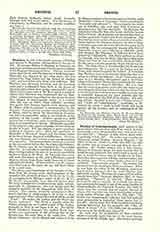

Photinus, heretic of the fourth century, a Galatian and deacon to Marcellus, Metropolitan of Ancyra; d. 376. He became Bishop of Sirmium in Pannonia, an important position on account of the frequent residence of the Emperor Constantius there. The city was more Latin than Greek, and Photinus knew both languages. Marcellus was deposed by the Arian party, but was restored by Pope Julius and the Synod of Sardica (343), and was believed by them to be orthodox. But Photinus was obviously heretical, and the Eusebian court-party condemned them both at the Synod of Antioch (344), which drew up the “macrostich” creed. Three envoys were sent to the West and in a synod at Milan (345) Photinus was condemned, but not Marcellus; communion was refused to the envoys because they refused to anathematize Arius. It is evident from the way in which Pope Liberius mentions this synod that Roman legates were present, and St. Hilary calls its sentence a condemnation by the Romans. Two years later another synod, perhaps also at Milan, tried to obtain the deposition of Photinus but this was impossible owing to an outbreak of the populace in his favor. Another synod was held against him at Sirmium; some Arianizing propositions from it are quoted by St. Hilary. The heretic appealed to the emperor, who appointed judges before whom he should be heard. For this purpose a great synod assembled at Sirmium (351). Basil, the supplanter of Marcellus as Bishop of Ancyra and the future leader of the Semi-Arians, disputed with Photinus. The heretic was deposed, and twenty-seven anathematisms were agreed to. Photinus probably returned to his see at the accession of Julian, like the other exiled bishops, for St. Jerome says he was banished by Valentinian (364-75). Eventually he settled in Galatia. Epiphanius, writing at about the date of his death, considered his heresy dead in the West. In Pannonia there were still some Photinians in 381, and a Photinian named Marcus, driven from Rome under Innocent I, found adherents in Croatia. In later writers, e.g., St. Augustine, Photinian is the name for any who held Christ to be a mere man.
We obtain some knowledge of the heresies of Photinus from the twenty-seven anathematisms of the council of 351, of which all but 1, 10, 12, 13, 18, 23, 24, 25 (according to St. Hilary’s order: 1, 10, 11, 12, 17, 22, 24, 25) and possibly 2 are directed against him. We have corroborative evidence from many writers, especially St. Epiphanius, who had before him the complete minutes of the disputation with Basil of Ancyra. The canons obviously misrepresent Photinus’s doctrine in condemning it, in so far as they sometimes say “Son” where Photinus would have said “Word”. He makes the Father and the Word one Person (prosopon). The Word is equally with the Father unbegotten, or is called a part of the Father, eternally in Him as our logos is in us. The latent Word (endiathetos) becomes the explicit Word (prophorikos) not, apparently, at the creation, but at the Incarnation, for only then is He really Son. The Divine Substance can be dilated and contracted (so St. Hilary translates platunesthai and sustellesthai, while Mercator’s version of Nestorius’s fourth sermon gives “extended and collected”). This is exactly the wording of Sabellius, who said that God platunetai, is broadened out, into Son and Spirit. To Photinus the expansion forms the Son, who is not, until the human birth of Christ. Hence before the Incarnation there is no Son, and God is Father and Word, Logopator. The Incarnation seems to have been conceived after a Nestorian fashion, for Photinus declared the Son of Mary to be mere man, and this is the best-known point in his teaching. He was consequently classed with Paul of Samosata; Jerome even calls him an Ebionite, probably because, like Mercator, he believed him to have denied the Virgin birth. But this is perhaps an error. He certainly said that the Holy Ghost descended upon Christ and that He was conceived by the Holy Ghost. By His union with the prophoric Word, Christ was the Son. The Holy Ghost is identified like the Word with the Unbegotten; He is a part of the Father and the Word, as the Word is apart of the Father. It is evident that Photinus went so far beyond Marcellus that it is unfair to call him his follower. In his Trinitarian doctrine he is a Modalist Monarchian, and in his Christology a Dynamistic Monarchian, combining the errors of Theodotus with those of Sabellius. But it is clear that his views were partly motivated by the desire to get away from the Ditheism which not only the Arians but even the Eastern moderates were unable to avoid, and he especially denounced the Arian doctrine that the Son is produced by the Will of the Father. His writings are lost; the chief of them were “Contra Gentes” and “Libri ad Valentinianum”, according to St. Jerome; he wrote a work in both Greek and Latin against all the heresies, and an explanation of the Creed.
JOHN CHAPMAN

